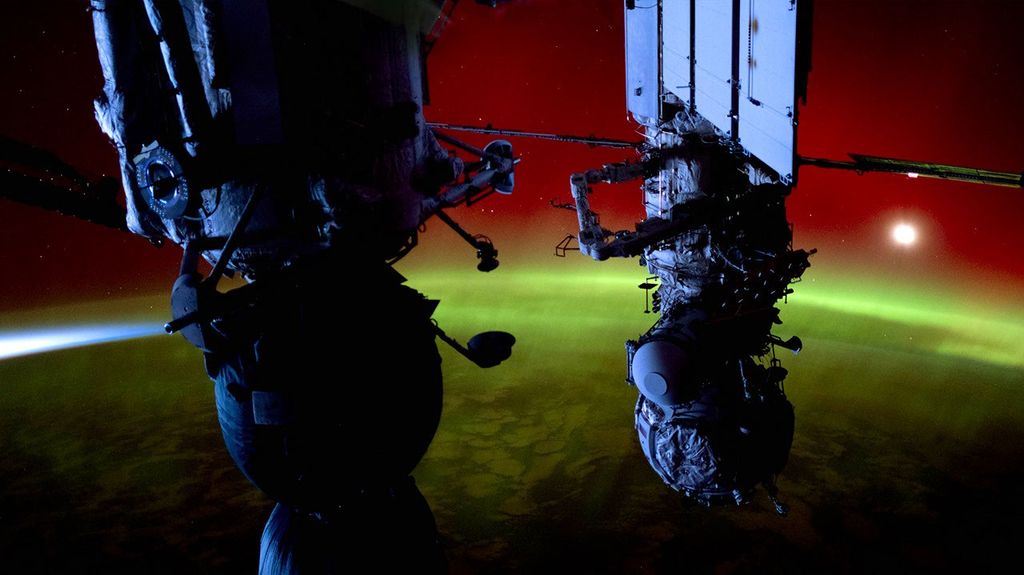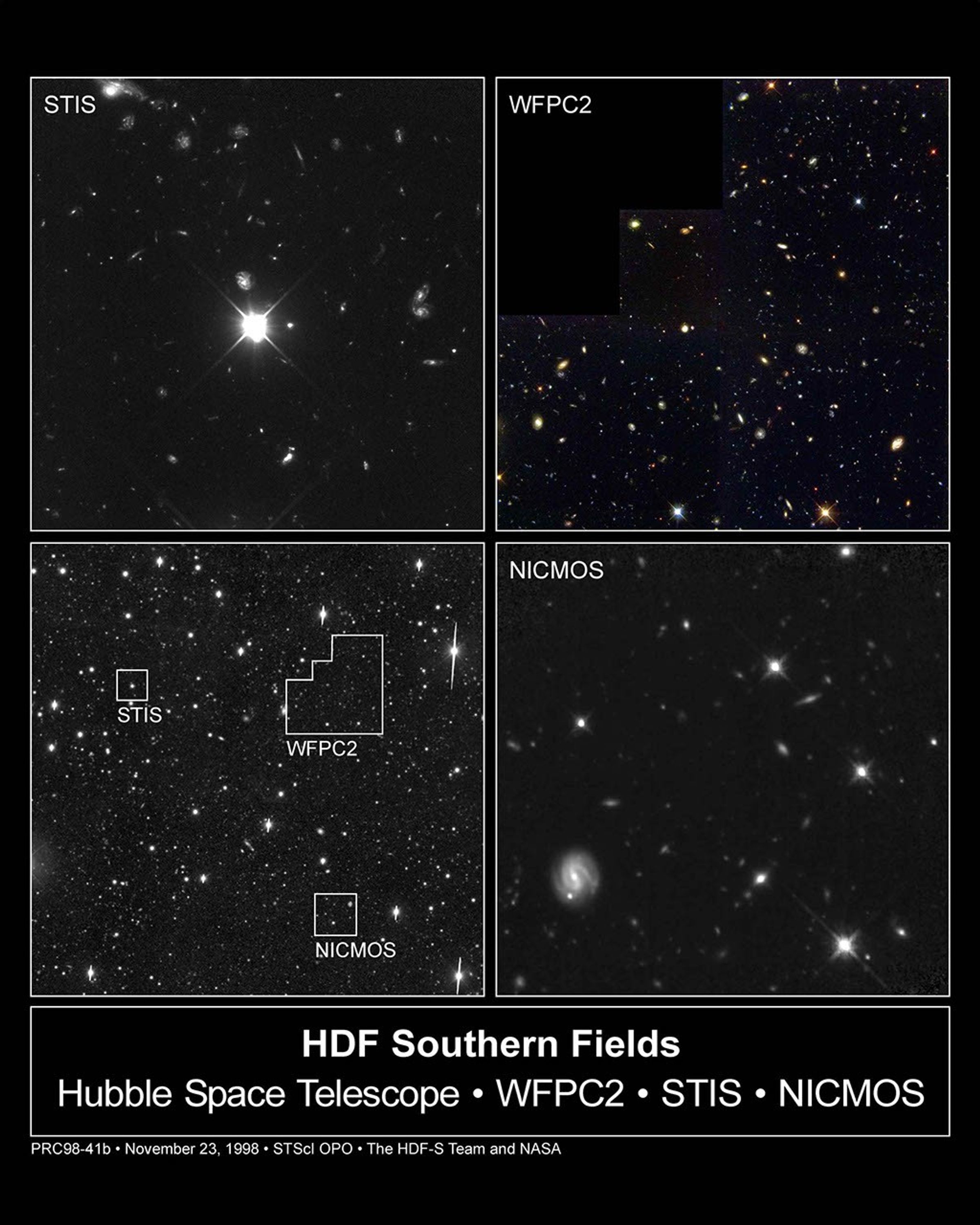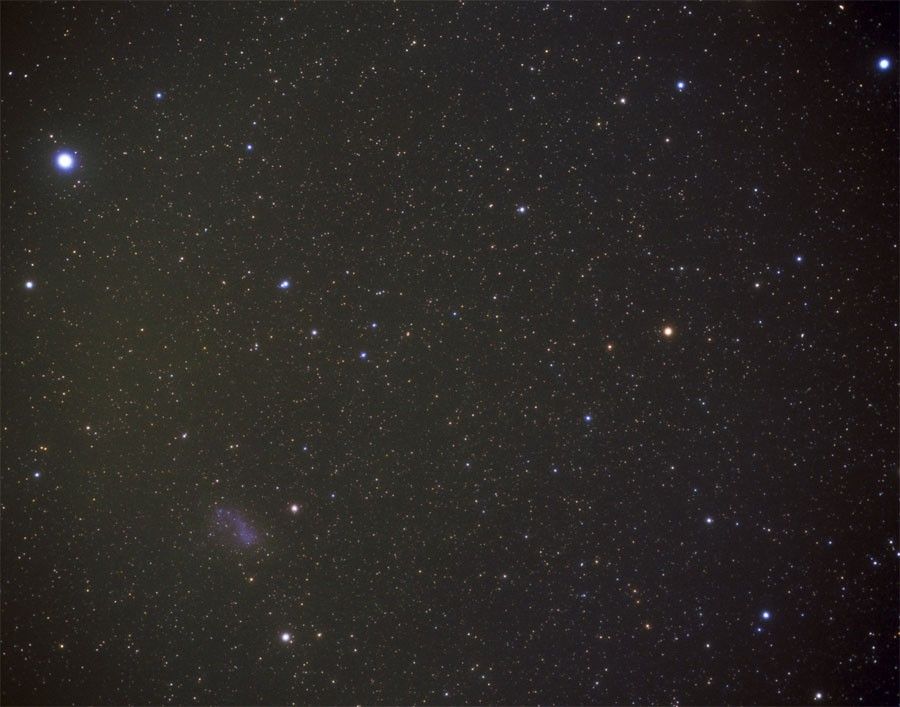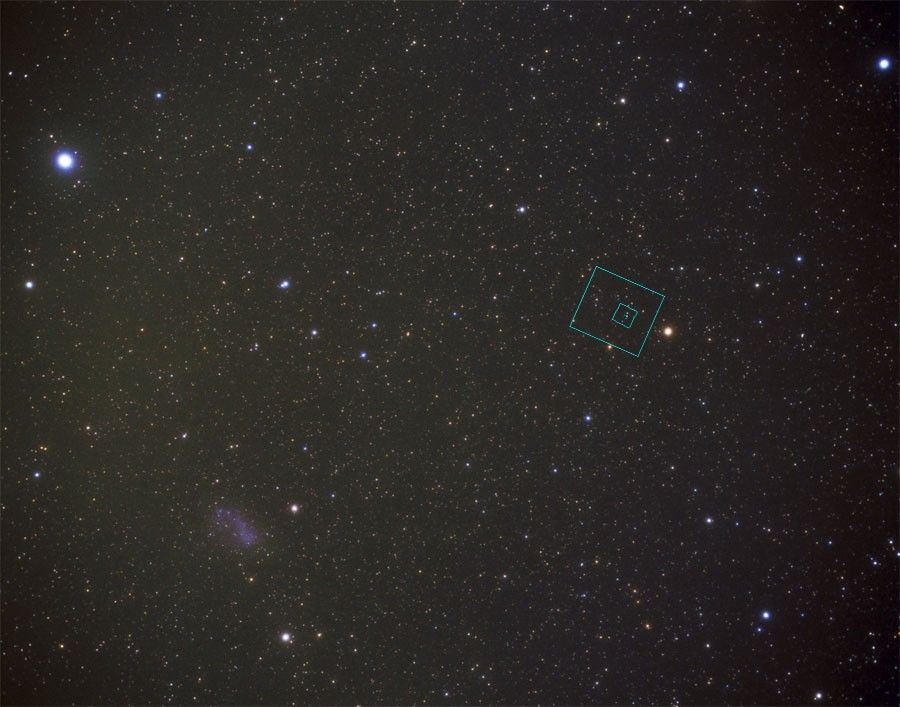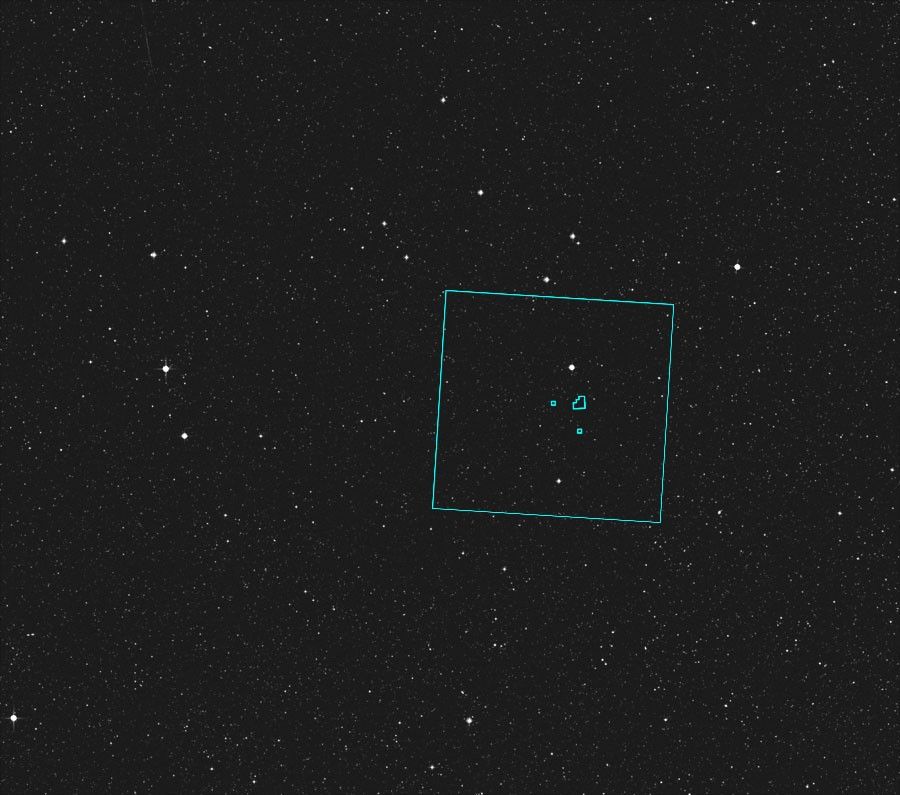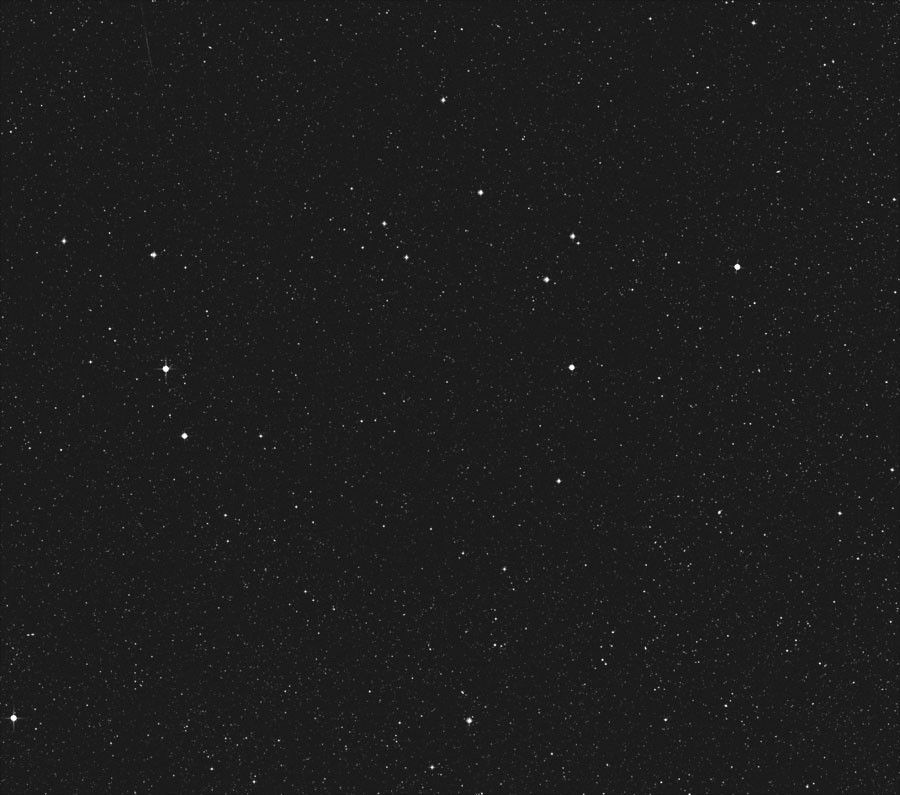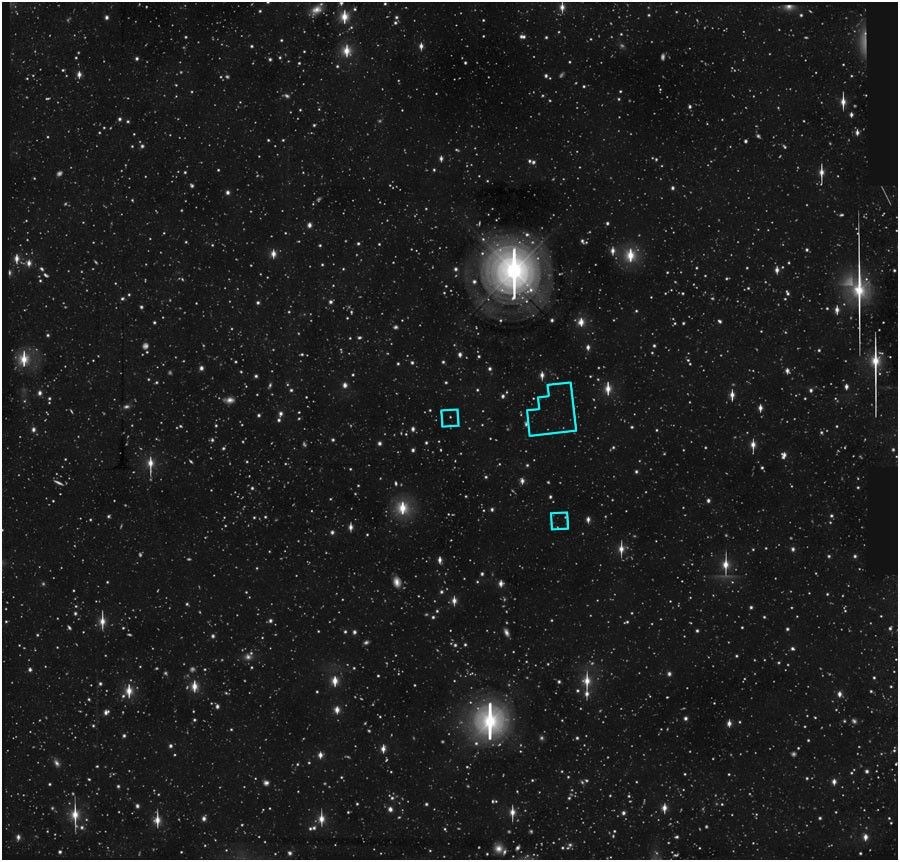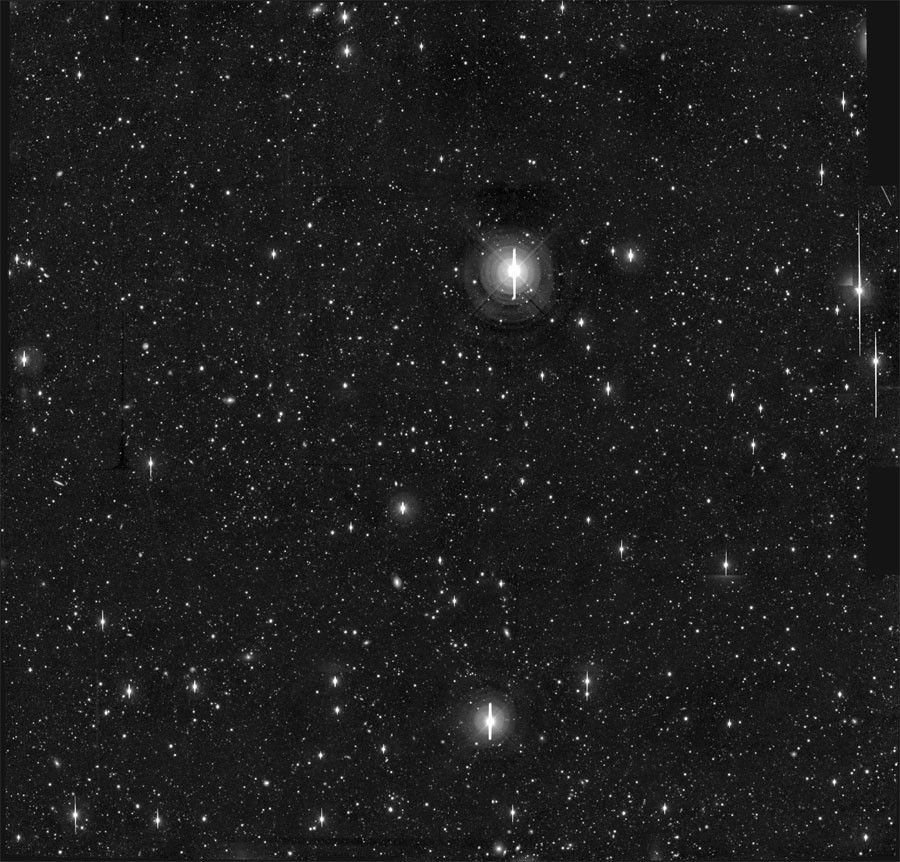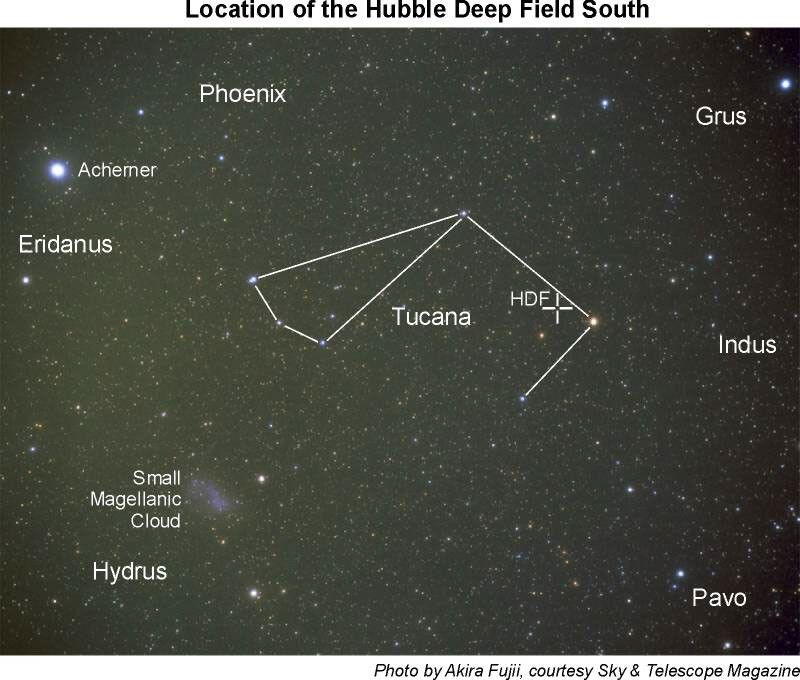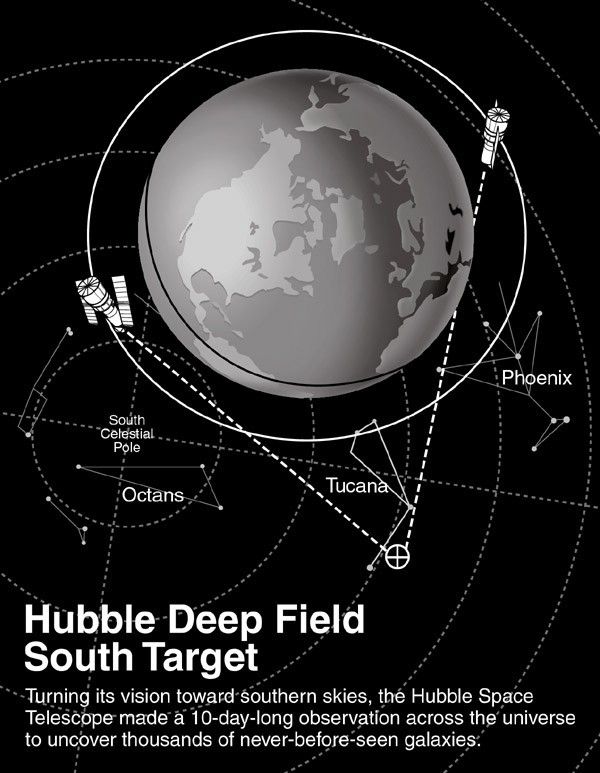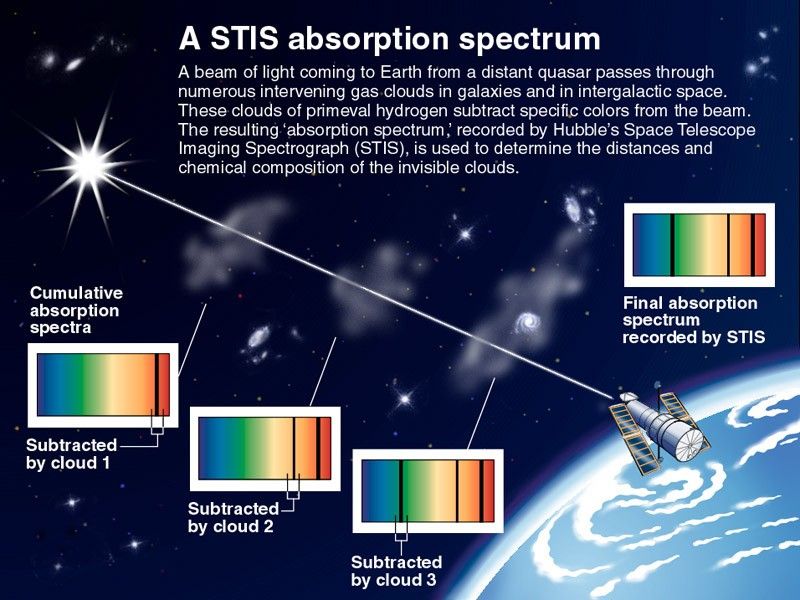Turning its penetrating vision toward southern skies, NASA's Hubble Space Telescope has peered down a 12 billion light-year long corridor loaded with a dazzling assortment of thousands of never-before seen galaxies. The observation called the Hubble Deep Field South (HDF-S) doubles the number of far-flung galaxies available to astronomers for deciphering the history of the universe.
This new far-look complements the original Hubble "deep field" taken in late 1995, when Hubble was aimed at a small patch of space near the Big Dipper. The new region is in the constellation Tucana, near the south celestial pole.
The 10-day-long observation was carried out in October 1998 by a team of astronomers at the Space Telescope Science Institute (STScI), Baltimore, MD, and NASA's Goddard Space Flight Center, Greenbelt, MD. It is being made available today to the worldwide astronomy community for further research, and to the general public interested in the most distant reaches of the cosmos.
"The southern field promises to be the most studied area of the sky over the next five years," says STScI astronomer Robert Williams, when as STScI Director, he used his discretionary time to undertake the first deep field campaign, and has overseen the latest observation.
"We have eagerly awaited this new set of images ever since the first HDF, which had a dramatic impact on the entire science of astronomy. Hubble's deep field views revealed a large, heretofore unseen fraction of the universe and opened it up to interpretation and understanding."
It will take months for astronomers to digest what new secrets of the universe are within this latest look. At first glance the HDF-S appears to validate the common assumption that the universe should look largely the same in any direction.
The two deep fields now give astronomers two "core samples" of the universe for better understanding the history of the cosmos. The pair of observations can be compared to more confidently infer the state of the cosmos as a whole. It would take astronomers 900,000 years to use Hubble to survey the entire sky to the depths of the HDF. So, they must rely on a thin "looking-through-soda straw" view across the cosmos and infer the history of star and galaxy formation.
The new deep field also provides an astronomical gold mine for powerful new ground-based telescopes located in the southern hemisphere to undertake follow-up observations of galaxies and precisely measure their distances.
All of Hubble's new cameras and other instruments were trained on the sky simultaneously for the observation. The Space Telescope Imaging Spectrograph was used to dissect light from a quasar (bright, active core of a distant galaxy) in its field of view. The light from the quasar has traveled nearly three-quarters of the way across the universe, and provides a powerful three-dimensional probe of the universe's hidden structure. Invisible clouds of primeval hydrogen gas strung along billions of light-years between us and the quasar will be detectable in the signature of the quasar's light. The quasar is so brilliant it is like a searchlight shining through haze.
The original HDF engaged hundreds of astronomers around the world. Broad conclusions were drawn based on meticulous follow-up studies of the myriad galaxies along Hubble's extremely narrow line-of-sight. To date, conclusions about the rate of star formation and evolution of galaxy shapes have been based on this one narrow "core-sample" of the universe. Because the original HDF was picked as a seeming bland example of what the universe at large probably looks like, astronomers have assumed it was a representative sample. But they needed a second sample to validate early assumptions, and they needed a field that contained a distant quasar to give them important additional information that the northern field did not contain.
BACKGROUND INFORMATION: PLANNING ANOTHER LOOK INTO DEEP SPACE
The Hubble Space Telescope's first deep probe into the heavens produced a unique gallery of thousands of faint galaxies, called the Hubble Deep Field. This long look into the cosmos was so successful that Space Telescope Science Institute astronomer Robert Williams decided to plan a sequel.
"I had wanted to undertake a second Deep Field shortly after the first," recalled Williams, who, as Institute director, used his discretionary time to make the original Hubble Deep Field observations in 1995. "When it became evident within a few months that researchers were drawing important conclusions from the data about the history of galaxy formation, I knew then that we had to conduct another Deep Field in a different area of the sky."
Williams also knew that one 10-day gaze into deep space wasn't enough. The Deep Field was, after all, a relatively small sample of remote galaxies. And yet, the information these objects yielded strengthened astronomers' knowledge of star formation and galaxy evolution. Astronomers, however, must study more faraway galaxies to assemble a clearer picture of our early universe.
They need another "core sample" of the sky. Basing conclusions on one sample of the heavens is similar to making judgements about the U.S. population by polling people who live along a 20 mile-wide strip from California to New England. To be reassured this was a representative "slice" of our country, researchers would want to make a second survey along a separate cross-continental strip.
Choosing a Location
For the sequel, Williams decided to go south. Picking a patch of sky in the Southern Hemisphere was fairly easy. The first time around, the Hubble telescope was pointed at a region of space in the Northern Hemisphere. So, for Hubble Deep Field Part 2, the southern sky seemed like a good choice. The southern region has a stable of powerful ground-based telescopes, including the European Southern Observatory's Very Large Telescope in Cerro Paranal, Chile. These telescopes will make important follow-up observations to establish distances to the faraway galaxies.
Astronomers also needed a region where the Hubble telescope has an unobstructed view of the heavens. There are only a few locations where Earth doesn't block the telescope's view, and those are regions of space above Earth's poles.
Quasar Added to the Picture
For this second observation, Williams wanted to add a very bright object to the mix of distant, faint galaxies. His choice: a quasar. Quasars are extremely bright and very distant objects believed to be powered by black holes residing in the cores of galaxies. Most of these light beacons formed very early in our universe, and their light takes billions of years to reach Earth. As the light from these faraway cosmic light bulbs travels through space, it illuminates invisible clouds of gas, revealing the secrets of galaxy evolution. In fact, quasars are so important that their study became one of the key reasons for the construction of the Hubble telescope.
Williams and his team of 50 astronomers and technicians tapped an Australian observatory to hunt for one of those distant light beacons in the southern sky. Two summers ago astronomers at the Anglo-Australian Observatory in Siding Spring, Australia, discovered a quasar about 9.5 billion light-years away. The Deep Field team then selected a target area around the quasar in October 1997 and conducted test observations with the Hubble telescope to ensure they had proper guide stars to keep the orbiting observatory steady during a long observation.
Three Cameras Study Wider Area
This time around the Deep Field team decided to broaden the observation by taking snapshots of a wider area: the target area and the region surrounding it. This broadened perspective is helpful for astronomers conducting follow-up surveys with ground-based telescopes.
The team used three Hubble telescope cameras to scrutinize this wider area: the Wide Field and Planetary Camera 2 (WFPC2), the Space Telescope Imaging Spectrograph (STIS), and the Near Infrared Camera and Multi-Object Spectrometer (NICMOS). Each camera specializes in gathering light from different areas of the light spectrum, from ultraviolet to infrared, and should provide astronomers with more information about remote objects.
Astronomers used only the wide-field camera during the original Deep Field observation. The infrared camera and the imaging spectrograph, which analyzes ultraviolet light, were placed aboard the telescope two years after the Deep Field campaign.
Hubble Deep Field: The Sequel
Two years after the initial planning, the Deep Field team was ready to make the observation. On Sept. 28, astronomers aimed the Hubble telescope on the same narrow slice of sky in the constellation Tucana. For two weeks, until Oct. 10, the telescope stared almost continuously at the same target, taking image after image in ultraviolet, optical, and infrared light. The observation consisted of 150 orbits of the primary field and 27 orbits of the flanking fields. The telescope snapped 995 exposures of the primary field. The average exposure time was 30 to 45 minutes. For the final pictures, astronomers combined several images to create the equivalent of a long exposure. These final images showcase a dazzling gallery of 2,500 galaxies.
The observation captured objects as dim as 30th magnitude, which is 6 billion times fainter than the human eye can see.
Astronomers used eight color filters to study the light from these distant objects. To understand stars and galaxies, astronomers must see them in different colors, which represent different sections of the light spectrum. By analyzing these colors, astronomers can, among other things, estimate the distances of objects, and their temperatures and velocities.
The wide-field camera collected light in near ultraviolet, blue, visible, and near-infrared wavelengths. Objects emitting light in infrared wavelengths was the focus of the infrared camera's observations. By studying information at these longer wavelengths, astronomers can calculate how far light from distant objects has been stretched to longer wavelengths by the expansion of space. The camera also is adept at capturing stars hidden in dusty galaxies. Astronomers used the imaging spectrograph to make ultraviolet-light images of objects such as a galaxy's hottest stars. The instrument also collected spectral information, which reveals the chemical composition of stars.
BACKGROUND INFORMATION: PA "KEYHOLE" VIEW OF THE COSMOS – KEY FINDINGS FROM THE HUBBLE DEEP FIELD
For 10 consecutive days in December 1995, NASA's Hubble Space Telescope stared at an almost empty speck of sky near the Big Dipper. The long-exposure view allowed the sharp eyes of the Hubble telescope's Wide Field and Planetary Camera 2 (WFPC2) to peer far across space, gathering light from some of the faintest galaxies in various stages of development. The resulting multicolor image, called the Hubble Deep Field, dazzled astronomers and the public. The picture revealed a dense jumble of dim galaxies, about 2,500 of them, some more than 12 billion light-years away. The Deep Field was the most detailed look into the heavens.
Since its unveiling in January 1996, astronomers have used an arsenal of ground-based telescopes to analyze the Deep Field and the region surrounding it. The telescopes have covered practically the entire spectrum of light, from X-ray, to visual, to infrared. Although the deep field is but a mere pinprick in the sky, the objects discovered have yielded a harvest of information.
Galaxy Colors Yield Clues about their Distances
Astronomers suspected that most of these galaxies were very distant from Earth. But how far away were they? Astronomers used two ways to find out. They obtained accurate distances by measuring the velocities of galaxies with ground-based telescopes. But many galaxies were beyond the range of ground-based observatories. That's when astronomers turned to the Deep Field exposures. By analyzing the colors in these exposures, astronomers were able to estimate distances.
Astronomers express distance in terms of redshift. Redshift is a measure of how fast galaxies are moving away from Earth. Since the universe is expanding, the more distant galaxies are receding at a faster rate and thus have a higher redshift. Once astronomers establish a galaxy's redshift, they can make a rough estimate of its distance. The distance isn't exact because the universe's expansion rate is not yet precisely known.
Using the 10-meter W.M. Keck atop Hawaii's Mauna Kea to measure the velocities of objects in the Deep Field, astronomers have obtained redshifts for 125 galaxies and roughly 500 more in the surrounding area.
For remote galaxies beyond the scope of ground-based telescopes, astronomers turned to another technique: using the Hubble telescope's color information to estimate galaxy distances. They did so by comparing Deep Field exposures taken through different color filters. Numerous galaxies seen in visible light abruptly vanished when viewed in ultraviolet light. That's because hydrogen gas absorbs ultraviolet light, and remote galaxies have the largest amount of this gas between them and Earth. The cumulative effect of the absorption is to make these galaxies essentially disappear in the ultraviolet (called ultraviolet dropout), like distant streetlights fading away in the morning haze.
Studies from the Hubble telescope and ground-based observatories indicate that astronomers can obtain reliable distances to remote galaxies by analyzing multicolor images of these faraway objects.
Astronomers even used this color analysis to identify a galaxy in the Deep Field 11.5 billion light-years away. The light reaching us from this galaxy was emitted when the universe was about one billion years old.
Using the color analysis and information from ground-based telescopes, astronomers have estimated distances for thousands of other Deep Field galaxies.
Irregular Galaxies
A surprisingly large number of galaxies have peculiar shapes, even some of the brightest. The relationship between these irregular galaxies and the much more organized galaxies seen around us today is not well understood. Part of the explanation for the apparent evolution in the shapes of galaxies may be that the wide-field camera sees only ultraviolet light from distant galaxies that has been stretched to visible wavelengths.
Using the new infrared camera, the Near Infrared and Multi-Object Spectrometer (NICMOS), astronomers have observed these distant galaxies in visible light that has been shifted to infrared wavelengths. Indeed, some galaxies exhibiting irregular shapes when viewed in ultraviolet light appear more normal when seen in the infrared. However, others retain their peculiar structure at longer, infrared wavelengths, showing that they're truly irregular.
Small, irregular galaxies fit a recipe for galaxy evolution in which objects evolved from the bottom up. In the bottom up model, galaxies began as tiny units, possibly small groups of stars, and these merged into ever-larger assemblies.
In Search of Hidden Stars
Most of the star formation in the universe may be taking place in dusty galaxies. Visible-light observations of the Deep Field showed that star formation peaked between 7 and 9 billion years ago. This result is consistent with earlier studies of the chemical composition of the intergalactic medium. These studies analyzed gas clouds along the line of sight to distant quasars. But the scarcity of bright star-forming galaxies at large distances is nonetheless surprising. Studies of nearby "elliptical" galaxies suggest they formed their stars very rapidly when the universe was just 1 to 3 billion years old. During the star formation phase they should have been very bright and numerous. The Deep Field shows a few bright star-forming galaxies, but not nearly enough. Perhaps the visible-light observations are missing much of the star birth action.
Dust obscures ultraviolet and visible light from galaxies, hiding them from view in observations like the Deep Field. It's not clear how important this effect is, but follow-up observations with telescopes that penetrate through the dust of distant galaxies have found rapid star birth possibly taking place. Infrared and radio telescopes and the new SCUBA, a telescope in Hawaii that sees through dust by gathering light in submillimeter-wavelengths, have found several objects with faint or invisible optical counterparts that may be very distant, dusty "starburst" galaxies.
















